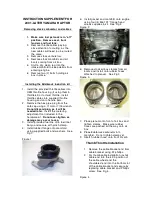
In the event of an accident, have a damaged
luggage compartment floor or loading area, the
lashing eyelets and the lashing material
checked at a specialist workshop. Otherwise,
the load may not be correctly secured the next
time anything is stowed.
Even if you adhere to all the loading guidelines,
an increased payload increases the risk of injury
in the event of an accident. Observe the infor-
mation in the "Securing a load" (
Y
page 314)
and "Load distribution" (
Y
page 313) sections.
You will find information about the maximum
roof load under "Lashing points and carrier sys-
tems" (
Y
page 389). You will find information
about roof carriers under "Carrier systems"
(
Y
page 321).
Before loading
!
The non-slip mats cannot be used for secur-
ing loads and must be replaced should the
following become apparent:
R
signs of deformation or development of
squashed areas
R
traces of cracking
R
cutting
X
Tyre pressure: check the tyre pressure and
correct if necessary (
Y
page 359).
X
Load compartment floor: clean the load
compartment floor.
The load compartment floor must be free from
oil and dust, dry and swept clean to prevent
the load from slipping.
X
Place non-slip mats (anti-slip mats) on the
load compartment floor if necessary.
When loading
X
Observe the permissible axle loads and per-
missible gross vehicle weight for your vehicle.
Take into account that your vehicle's unladen
weight is increased if accessories or optional
equipment are fitted. The maximum payload
is thus reduced.
X
Observe the notes on load distribution
(
Y
page 313).
The overall centre of gravity of the load should
always be as low as possible, centred and
between the axles near the rear axle.
X
Secure the load (
Y
page 314).
Observe the legal requirements of the country
in which you are currently driving.
Checking the load
G
WARNING
Combustion engines emit poisonous exhaust
gases such as carbon monoxide. If the tail-
gate/rear door is open when the engine is
running, particularly if the vehicle is moving,
exhaust fumes could enter the passenger
compartment. There is a risk of poisoning.
Turn off the engine before opening the tail-
gate/rear door. Never drive off with the tail-
gate/rear door open.
X
Securing luggage/loads: make sure that
the luggage and/or load is secure before
every journey and at regular intervals during a
long journey, and correct it if necessary.
X
Doors/tailgate: close the sliding doors and
tailgate/door.
X
Headlamps: adjust the headlamp light cone
if necessary. Adjust headlamp range
(
Y
page 116).
X
Tyre pressure: adjust the tyre pressure
according to the vehicle load (
Y
page 359).
X
Handling characteristics: adapt your driv-
ing style according to the load being trans-
ported.
Load distribution
General notes
!
Excessive loads on individual points of the
load compartment floor or on the load surface
impair vehicle handling characteristics and
could cause damage to the floor covering.
Load distribution
313
Transporting loads with the vehicle
Z
















































